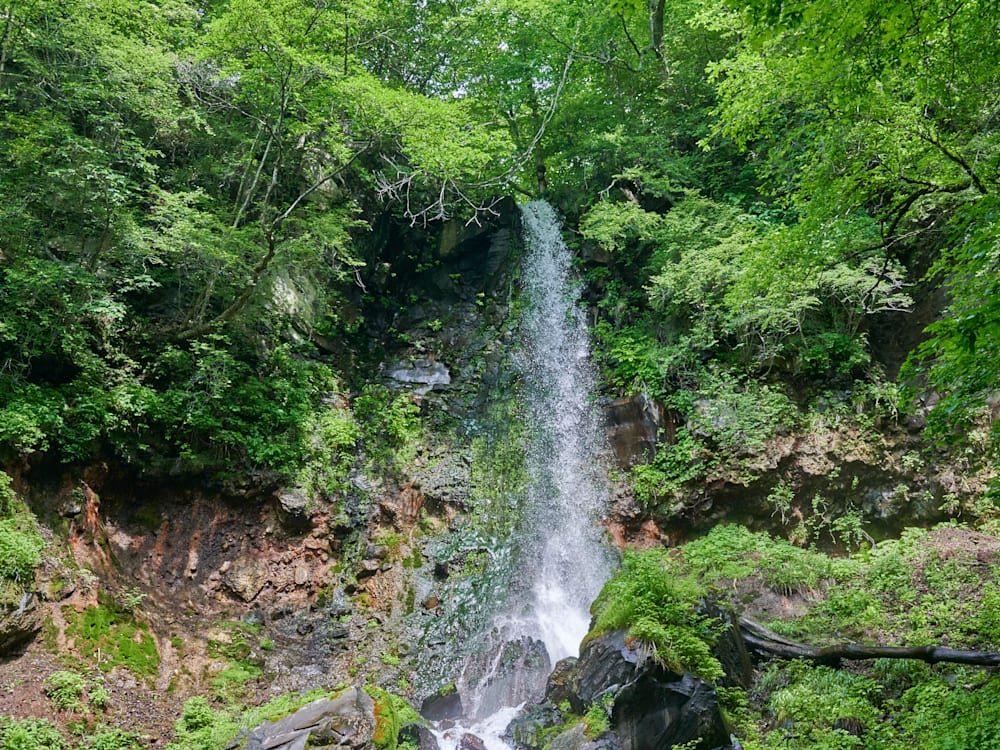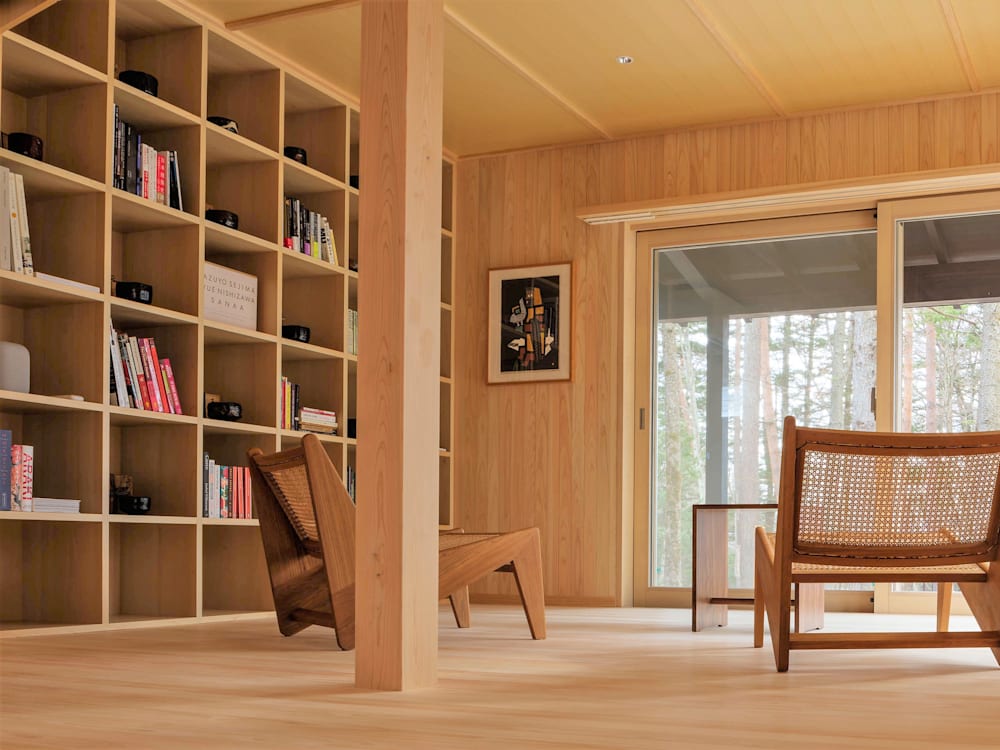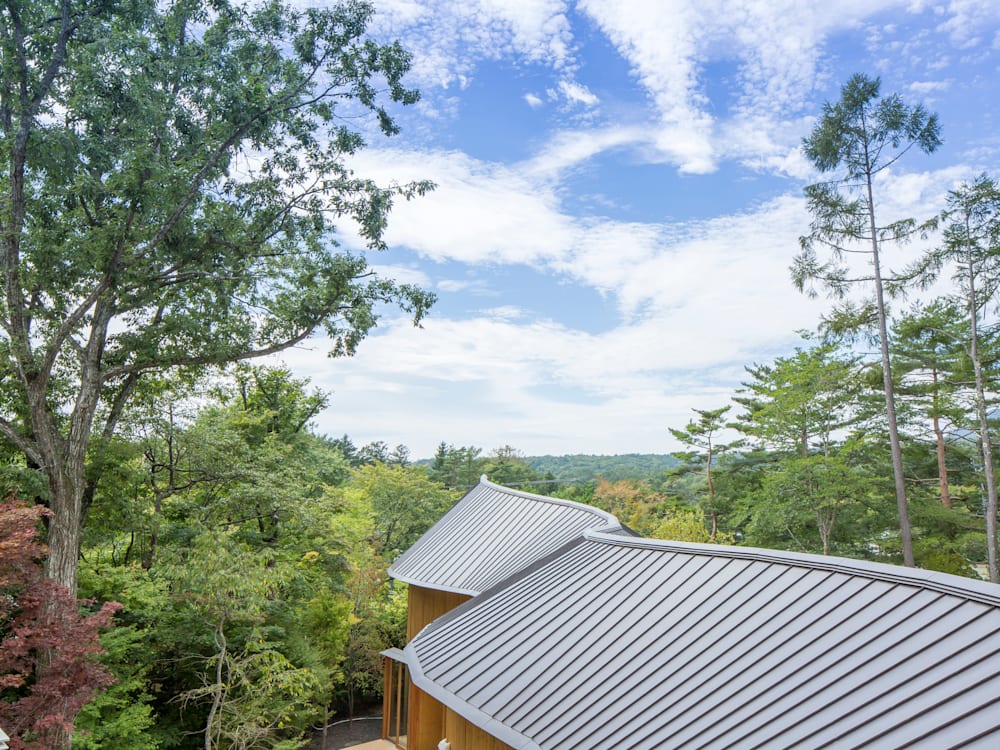For all the cultivated airs of Japanese resort town Karuizawa — its boulangeries and coffee roasteries, ceramics studios and art galleries — Mount Asama is a stoical, omnipresent reminder of the area’s wild nature. Its cone is smoking into the clear blue sky when I step off the bullet train from Tokyo on a winter’s morning, while its molten depths heat the mineral springs that have made this part of Nagano Prefecture such a popular weekend retreat for well-to-do Tokyoites. Look up Karuizawa on Google Maps and you’ll see an elongated wishbone of a town squished between various swathes of green: bird sanctuaries, ski resorts, hiking trails scattered with Shinto shrines and waterfalls.

Shishi-Iwa House does the same thing in microcosm, slotting itself in origami-esque style around the trees. Guest rooms and social spaces are dispersed into three structures, none peeping higher than the woodland canopy, while timber and glass make an effective forest camouflage, as if the property’s playing hide-and-seek among the pines. In fact, it’s easy to miss the place entirely as you follow the main road north out of Karuizawa.
This was, of course, entirely intended by the pair of big-name, Pritzker Prize-winning Japanese architects behind it, Shigeru Ban and Ryue Nishiza. ‘The first thought was to gently insert the building between the trees without cutting them,’ Ban says of House No. 1, completed in 2018. In a first for any Japanese hotel, his modular design saw wooden A-frames and prefabricated PHP (plywood filled with paper honeycomb) transported to the site and assembled between the maples, cherries, larches and oaks that already existed there.
Long before mass-timber became a trendy, low-carbon alternative to steel and concrete, Ban was crafting it into iconic public buildings like the Centre Pompidou-Metz and Mount Fuji World Heritage Centre. His other humble hero material, recycled cardboard tubing (he’s even made a cathedral out of the stuff), also gets a strong showing at Shishi-Iwa House — check out his Carta lounge chairs and bespoke headboards.
While eco-friendly building materials may not be the sexiest subject, sleeping in one of Ban’s timber temples turns sustainability into a sensory experience. Double-height spaces are wrapped in intricate lattices and beams, showing off the warm, honeyed hue of Japanese cedar, the calligraphic patterns of its grain. Over in Nishizawa’s House No. 03, hinoki cypress — considered a sacred material in Japan, where it’s long been used for Buddhist temples and Shinto shrines — suffuses interiors with its distinctive citrusy aroma.

All the buildings blur the lines between inside and outside, whether it’s No. 03’s courtyard gardens and traditional engawa external walkways between the pavilion-like rooms, or six-metre-high, bi-folding doors that peel one side of No. 01 open entirely in warmer months. Foliage is framed at every turn. Minimalist interiors (with only the occasional abstract painting by Masaaki Yamada or Toshimitsu Imai injecting some colour) let nature take centre stage. Watching how the grounds are painted by the seasons’ changing palettes is the go-to, lo-fi form of entertainment here, given the absence of televisions and the patchy WiFi: blushing with cherry blossom, dripping in summer greenery, aflame during fall, or the austere, monochrome magic of winter, when the snow-dusted forest resembles a Japanese woodblock print.
Through floor-to-ceiling windows, my partner and I practise shinrin-yoku (forest bathing) from our suite’s handmade hinoki bath tub and the library’s Alvar Aalto armchairs (part of a covetable collection of mid-century design, alongside Arne Jacobsen’s 1958 Swan Chair and a 1859 Bentwood Stool by Michael Thonet). When daylight fades, a soaring bow-shaped metal Yumi lamp provides a warm glow as we borrow reading material from the mezzanine bookshelves. It’s in one of these tomes that I learn four seasons isn’t even the half of it when it comes to Japanese nature-appreciation. Their calendar divides the year into 24 solar terms and a whopping 72 micro-seasons (kō), encouraging aspiring ecotherapy devotees to tune into even subtler transitions. Each only about five days long, kō have pleasingly poetic, bucolic descriptors, with my stay landing during ‘pheasants start to call’, just ahead of ‘butterburs bud’ and ‘ice thickens on streams’. Despite listening closely, I didn’t hear said bird but I did catch the telltale stutter of some red-headed woodpeckers.
At Shishi-Iwa House’s fine-dining restaurant, Shola, tasting menus shapeshift with the seasons, too. There are bursts of citrus (yuzu-anointed amberjack sashimi, mandarin with a creamy mozzarella and carrot sorbet in a pre-dessert palate-cleanser), as well as sweet, juicy snow crab and the umami earthiness of foraged mushrooms, folded with egg yolk in the comforting, risotto-like dish ojiya, for instance: the shining stars of the current solar term of Daikan, meaning ‘deeper cold’.

A course enigmatically called ‘From the farm…’ — a box of vibrant local vegetables — is brought to the table for us to admire the bounty in its raw form, before chef Masashi Okamoto preps them into a delicate salad. It’s a combination of the cooler climate and volcanic, ash-rich soil, the waiter explains, that makes Nagano produce so renowned. He points in the direction of Mount Asama with a reverent nod. Take matsutake mushrooms, which only grow in the wild, flourishing beneath pine trees in this cool, damp climate, and making them Japan’s most expensive mushroom. Shola’s menu even includes a map that illustrates regional suppliers, letting us know exactly who reared tonight’s venison or grew the apples gracing our pudding (a riff on pillowy, sugar-dusted mochi doughnuts).
This is food that gives a quiet and respectful bow to its natural surroundings, just as the architecture does. Combining ecotherapy and epicureanism, not forgetting a formidable collection of mid-century furniture, Shishi-Iwa House shows a sustainable hotel stay can be more like donning a silk kimono than wearing a hair shirt.
See more of our Revival Stories, from Devon to the Dolomites



